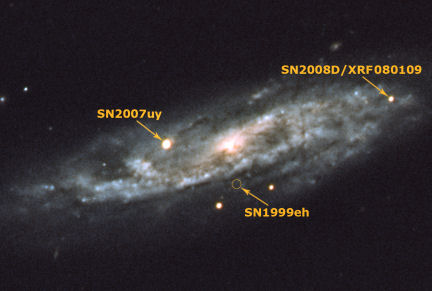Ready, set, supernova
For the first time, scientists have caught a star in the act of exploding.
By Emily Sohn
Stars explode all the time in outer space, but astronomers usually see the explosions only after they’ve happened. One type of stellar explosion, called a supernova, can glow for days or even months. Now, for the first time, scientists have actually caught a star in the act of going supernova.
The research team was using NASA’s Swift spacecraft to study a galaxy called NGC 2770. They had aimed the spacecraft’s X-ray telescope at a recently discovered supernova. Supernovas are dramatic explosions that happen when a really big star (as least eight times as big as our sun) runs out of fuel. Exploding stars release a lot of energy, much of it in the form of X rays.
 |
|
Without actually looking for it, astronomers found the supernova SN 2008d through X-ray observations. This is the first time scientists have observed a star shortly before it showed any evidence of exploding. Two other supernovas labeled here were found in this galaxy last year and in 1999.
|
| A. de Ugarte Postigo/ESO et al., Dark Cosmology Centre/Univ. of Copenhagen, Instituto de Astrofísica de Andalucía (CSIC), and Univ. of Hertfordshire |
Just as the telescope began observing the target supernova, the spacecraft recorded a fresh batch of X rays coming from another region in the same galaxy. The X-ray burst lasted for about 7 minutes.
Although no supernova was visible, these scientists suspected they had just witnessed the beginning of a star undergoing such a catastrophic explosion. Using the Gemini North telescope on the Hawaiian mountain Mauna Kea, the researchers then took another look at the same spot in the sky as where the X-ray burst had been. The region is now called SN 2008d. There they saw a visible-light display, which confirmed that a supernova had indeed occurred.
Astronomers usually can’t spot supernovas until the stars send out large amounts of visible light. By then, however, key information about early stages of the explosive process has vanished.
In the case of SN 2008d, the energy and length of the initial release of X rays suggest that the star was compact. Also, it hurled out lots of gas—called a stellar wind—from its surface before it went supernova.
For decades, scientists predicted that supernovas would send off X rays right before exploding. Now they finally have evidence that they were right.
The new discovery suggests that astronomers might be able to use wide-angle X-ray telescopes to catch the very beginnings of hundreds of supernova explosions each year.
Going Deeper:
Cowen, Ron. 2008. Supernova outbreak: X rays signal earliest alert. Science News 173(March 8):148. Available at http://www.sciencenews.org/articles/20080308/fob3.asp .
Sohn, Emily. 2007. A great ball of fire. Science News for Kids (May 16). Available at http://www.sciencenewsforkids.org/articles/20070516/Note2.asp .
______. 2006. Dead star exploding. Science News for Kids (Aug. 9). Available at http://www.sciencenewsforkids.org/articles/20060809/Note2.asp .
______. 2006. Spotlight on an exploding star. Science News for Kids (March 8). Available at http://www.sciencenewsforkids.org/articles/20060308/Note3.asp .







